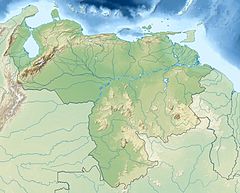Aroa River (Venezuela)
| Aroa River | |
|---|---|
 | |
| Native name | río Aroa (Spanish) |
| Location | |
| Country | Venezuela |
| Physical characteristics | |
| Mouth | |
• location | Boca de Aroa, Falcón, Venezuela |
• coordinates | 10°41′05″N 68°17′49″W / 10.684818°N 68.296895°W |
The Aroa River (Spanish: Río Aroa) is a river in northwestern Venezuela. It runs parallel and west of the Yaracuy River. The Aroa River empties into the Caribbean Sea.
The river drains part of the Lara-Falcón dry forests ecoregion.[1]
In the 16th century it was known that there was gold in the Yaracuy, Santa Cruz and Aroa rivers, and in 1605 gold deposits were found in a small valley leading to the Aroa River.[2] The king gave the Aroa mines in perpetuity to Dr. Francisco Marín de Narváez and his heirs in exchange for 40,000 pesos.[3]
In 1824 the mines were leased to British entrepreneurs who exploited deposits of copper.[4] They used the Aroa River to carry the ore by barge to the coast, where it was loaded onto ships.[5] The town of Aroa was the first town in the country to obtain electricity and telephone service. A cableway was built linking the mines to the town.[5]
References
- ^ Locklin.
- ^ Silva 1993.
- ^ Parque Bolivariano Minas de Aroa – Yaracuy.
- ^ Yarrington 1997, p. 18.
- ^ a b Maddicks 2011, p. 342.
Sources
- Locklin, Claudia, Northern South America: Northern Venezuela (NT0219), WWF: World Wildlife Fund, retrieved 2017-04-28
- Maddicks, Russell (2011-02-01), Venezuela: The Bradt Travel Guide, Bradt Travel Guides, ISBN 978-1-84162-299-6, retrieved 2016-08-17
- "Parque Bolivariano Minas de Aroa", Yaracuy, 21 May 2011, retrieved 2016-08-17
- Silva, Ricardo (27 September 1993), An introduction to artificial cavities in Venezuela during the colonial period, Caracas: Centro de exploraciones espeleológicas de la Universidad Simón Bolívar, archived from the original on 2020-10-22, retrieved 2016-08-17
- Yarrington, Douglas (1997-12-15), A Coffee Frontier: Land, Society, and Politics in Duaca, Venezuela, 1830–1936, University of Pittsburgh Pre, ISBN 978-0-8229-7494-9, retrieved 2016-08-17

